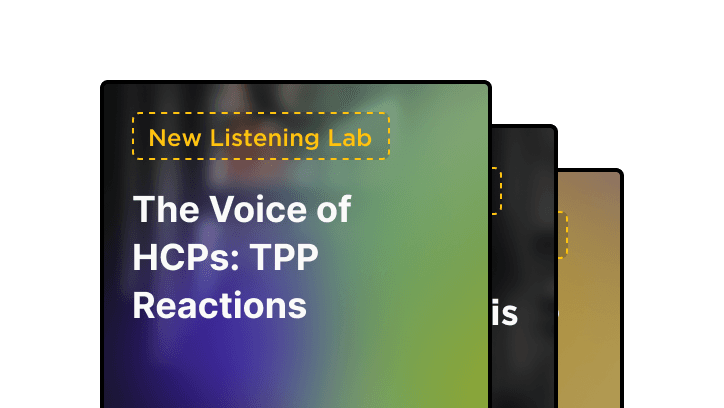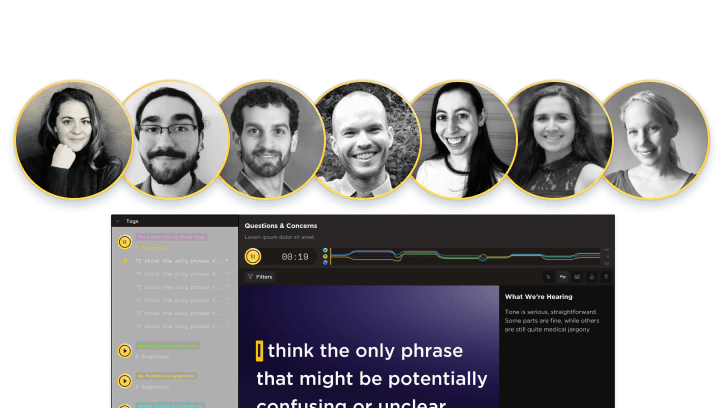Use Case
Target Product Profile (TPP)
Case Study
Exploring HCP Reactions to TPPs to Inform Pre- and Post-launch Strategies
Client Goal
To prepare for the upcoming launch of their product, our client wanted to assess specific elements of their label and messaging in their target product profile (TPP) to understand the potential impacts of this information on HCP decision-making in the treatment of moderate to severe psoriasis.
Objective 1
Uncover HCP reactions to blinded product profiles to gain insight into how specific aspects of the described treatments impact their prescribing habits.
Objective 2
Identify key differences between profiles and compare HCP interest, excitement, and willingness to use the client treatment and competitors (in-market and pre-market).
The inVibe Solution
inVibe’s Target Product Profile solution allowed our pharmaceutical client to quickly and efficiently deploy a mixed-methods (quant + voice) study to understand how HCPs react to different TPPs and determine how market changes could affect future prescribing behaviors.
1. Collect
Within a few days, inVibe screened and recruited 50 HCPs who treat patients with moderate to severe psoriasis to complete a mixed methods study. All HCPs initially completed a brief quantitative survey; immediately followed by a subset (n=20) who participated in an automated phone interview, responding to questions simply by speaking.
Key Questions
Q1
Please refer back to the Product X profile, an oral product in-development for moderate to severe plaque psoriasis. Imagine you are speaking to a colleague who also manages moderate and severe psoriasis patients. How would you describe Product X to your colleague and what makes it different from other treatments currently available for psoriasis?
Q2
Let’s look at another oral hypothetical product profile – Profile J, and imagine you’re speaking to that same colleague again. How would you describe Profile J and what makes it different from other treatments currently available for psoriasis?
Q3
Reviewing Profile J in greater depth, what are your overall thoughts and reactions to the specific information around the safety of Profile J? Which of these elements has the largest impact, either positive or negative, on your perception and anticipated use? Why?
Q4
Continuing to think about Profile J and Profile X how, if at all, would your intended use of the treatment differ between the two profiles? Why? And what additional information would help you increase your comfort in prescribing it?
2. Analyze
inVibe’s analysts leveraged their language expertise and advanced NLP tools to process, evaluate, and analyze multiple aspects of each response, including content, language, and emotion derived from speech-emotion recognition, allowing for deeper insights, faster.
What is Said
Summarize and categorize the content and themes
How it’s Said
Identify the language patterns and construction
How it Sounds
Utilize machine learning and acoustic technology to assess the emotionality
3. Deliver
The client was provided with an interactive report via an online dashboard, along with the voice data, transcripts, and a detailed analytical report at each phase. In-house analysts walked the client through the most meaningful data, supporting each insight with specific voice data.
Audiogram
Videos
Clients have access to drag & drop tools to instantaneously create kinetic text animations from transcripts for internal sharing.

Listening
Labs
inVibe delivers self-guided interactive stories assembled from transcripts, audio, and charts – annotated with high-level expert observations.

Expert
Perspective
inVibe’s team of in-house analysts and language experts walk clients through the insights and recommendations derived from the research.


Key Insights & Recommendations
Based on the insights, inVibe recommended the team take strategic actions:
#1
Message HCPs on best practices around monitoring for and managing potential adverse events associated with the treatment to reduce uncertainty and assuage concerns that decreased anticipated usage of other therapies whose TPPs include more expansive safety warnings.
#2
Leverage long-term data, favorable KOL opinions, and continue to educate on MOA differentiation to enhance comfort with the client’s treatment.
Where are they now?
Our client used the research to better understand the impact of specific TPP elements related to potential safety guidelines and to prepare to manage these HCP concerns at launch.
Today, our client’s product has launched with messaging designed to address potential safety concerns from HCPs and to support HCPs to have better conversations with their patients about treatment risks. They have reiterated that having this information ahead of launch allowed them to adequately preempt concerns that could have negatively affected uptake.
Ready to learn more?
/voice
/resources
/use-cases
- New Data Intelligence
- TrialPulse — Evaluation of Clinical Trial Recruitment Assets
- Concept / Message Testing
- Customer Journey Inflection Points
- Agency Pitch for New Business
- TrialPulse — DCT Design and Informed Consent
- Language of Disease
- Customer Stories
- Decision Drivers
- Market Trends
- TrialPulse — Disease Burden and Endpoint Selection
- HCP – Patient Communication
2025 inVibe - All Rights Reserved
